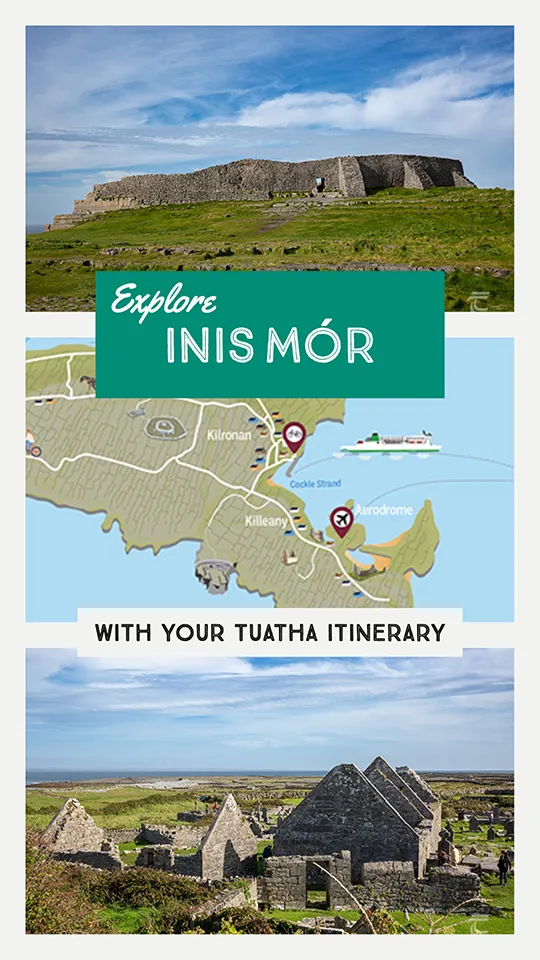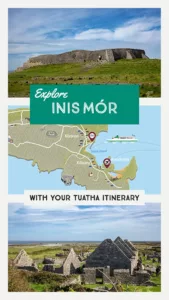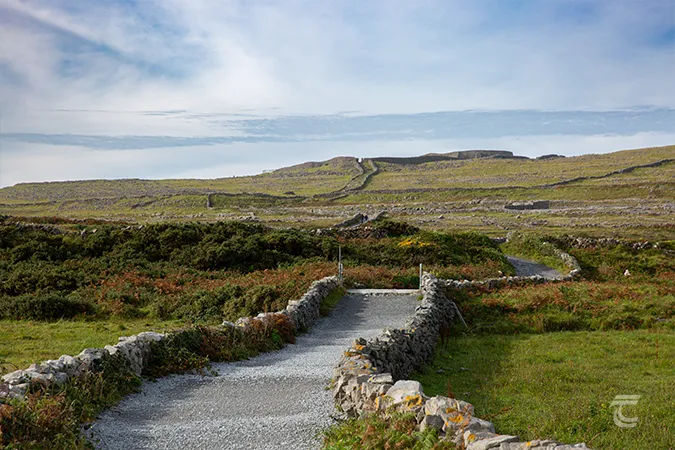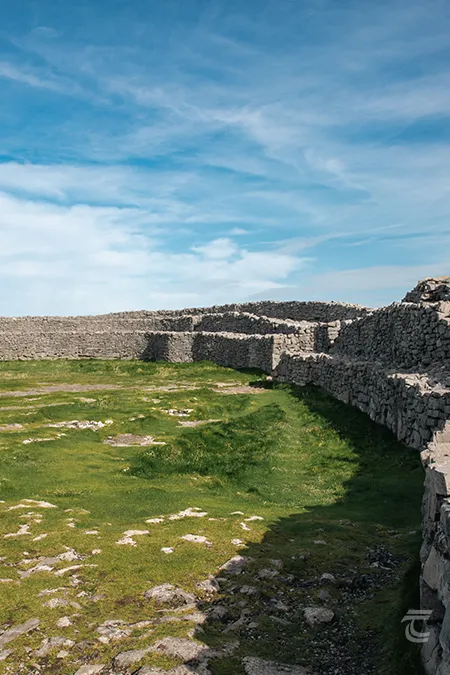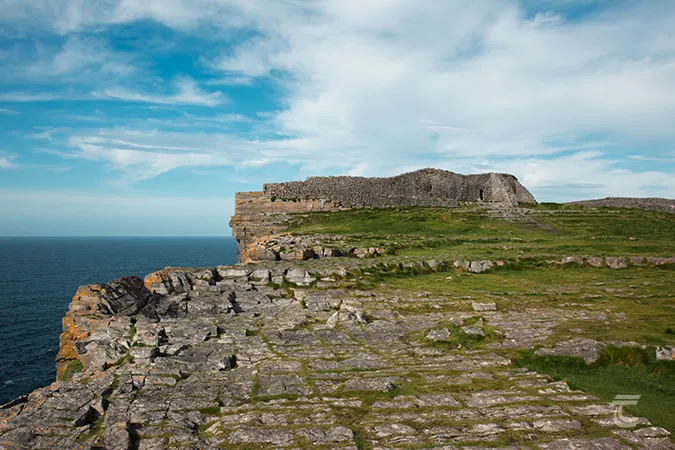Dún Aonghasa | Dun Aengus
The Aran Islands are situated in the Atlantic Ocean off the coast of Clare and Galway. These beautiful islands are full of stories, with history and heritage around every corner. Archaeologically, they are renowned for their important ancient monasteries and their spectacular stone forts. There are seven key stone forts on the Aran Islands: Dún Aonghasa (also known in its English spelling as Dun Aengus), Dún Eoghanachta, Dún Eochla and Dún Dúchathair on Inis Mór; Dún Chonchúir and Dún Fearbhaí on Inis Meáin; and Dún Formna on Inis Oírr. These iconic forts are truly monumental in size with diameters ranging from 27m to 90m. Dún Aonghasa is the oldest, and perhaps most famous, of all these seven.
The site encompasses an area of almost 5.8 hectares (14 acres), and is defined by a series of three curving walls forming an outer, middle and inner enclosure that terminate at the edge of a breathtakingly sheer cliff. The earliest activity here dates back to the Middle Bronze Age, around 3,500 years ago, though evidence suggests that the majority of the fort’s visible remains had their origin in the later Bronze Age, c.1100 BC, when the enclosures of the fort were first constructed.
The outer enclosure was first established in around 1000 BC. Though the drystone walls are quite low, the outer enclosure was constructed along the edge of a natural terrace which helped to make it a formidable sight for anyone approaching the fort. The area that the wall encloses is very exposed to the weather, and during the excavations, no evidence of habitation was found. The outer enclosure may have been a place to pen livestock, or it may simply have been constructed to form a mental and physical ‘boundary’ or separation from the surrounding landscape.
The middle enclosure not only provided shelter from the south-westerly winds but also got the best of the available sunshine. In the Bronze Age, the middle and inner enclosure walls were about 2m high and 2m thick. By the early medieval period, builders had increased the original walls so that they now stood at 6m high and 5m wide in places. The inner enclosure, protected by the two outer enclosures may only have been accessible to people of higher status, which could be based on a persons age, ancestry, family, gender or rank.
For practical information about visiting this site Click Here
The Aran Islands are situated in the Atlantic Ocean off the coast of Clare and Galway. These beautiful islands are full of stories, with history and heritage around every corner. Archaeologically, they are renowned for their important ancient monasteries and their spectacular stone forts. There are seven key stone forts on the Aran Islands: Dún Aonghasa (also known in its English spelling as Dun Aengus), Dún Eoghanachta, Dún Eochla and Dún Dúchathair on Inis Mór; Dún Chonchúir and Dún Fearbhaí on Inis Meáin; and Dún Formna on Inis Oírr. These iconic forts are truly monumental in size with diameters ranging from 27m to 90m. Dún Aonghasa is the oldest, and perhaps most famous, of all these seven. It encompasses an area of almost 5.8 hectares (14 acres), and is defined by a series of three curving walls forming an outer, middle and inner enclosure that terminate at the edge of a breathtakingly sheer cliff. The earliest activity at the site dates back to the Middle Bronze Age, around 3,500 years ago, though evidence suggests that the majority of the fort’s visible remains had their origin in the later Bronze Age, c.1100 BC, when the enclosures of the fort were first constructed.
The outer enclosure was first established in around 1000 BC. Though the drystone walls are quite low, the outer enclosure was constructed along the edge of a natural terrace which helped to make it a formidable sight for anyone approaching the fort. The area that the wall encloses is very exposed to the weather, and during the excavations, no evidence of habitation was found. The outer enclosure may have been a place to pen livestock, or it may simply have been constructed to form a mental and physical ‘boundary’ or separation from the surrounding landscape.
The middle enclosure not only provided shelter from the south-westerly winds but also got the best of the available sunshine. In the Bronze Age, the middle and inner enclosure walls were about 2m high and 2m thick. By the early medieval period, builders had increased the original walls so that they now stood at 6m high and 5m wide in places. The inner enclosure, protected by the two outer enclosures may only have been accessible to people of higher status, which could be based on a persons age, ancestry, family, gender or rank.
For practical information about visiting this site Click Here
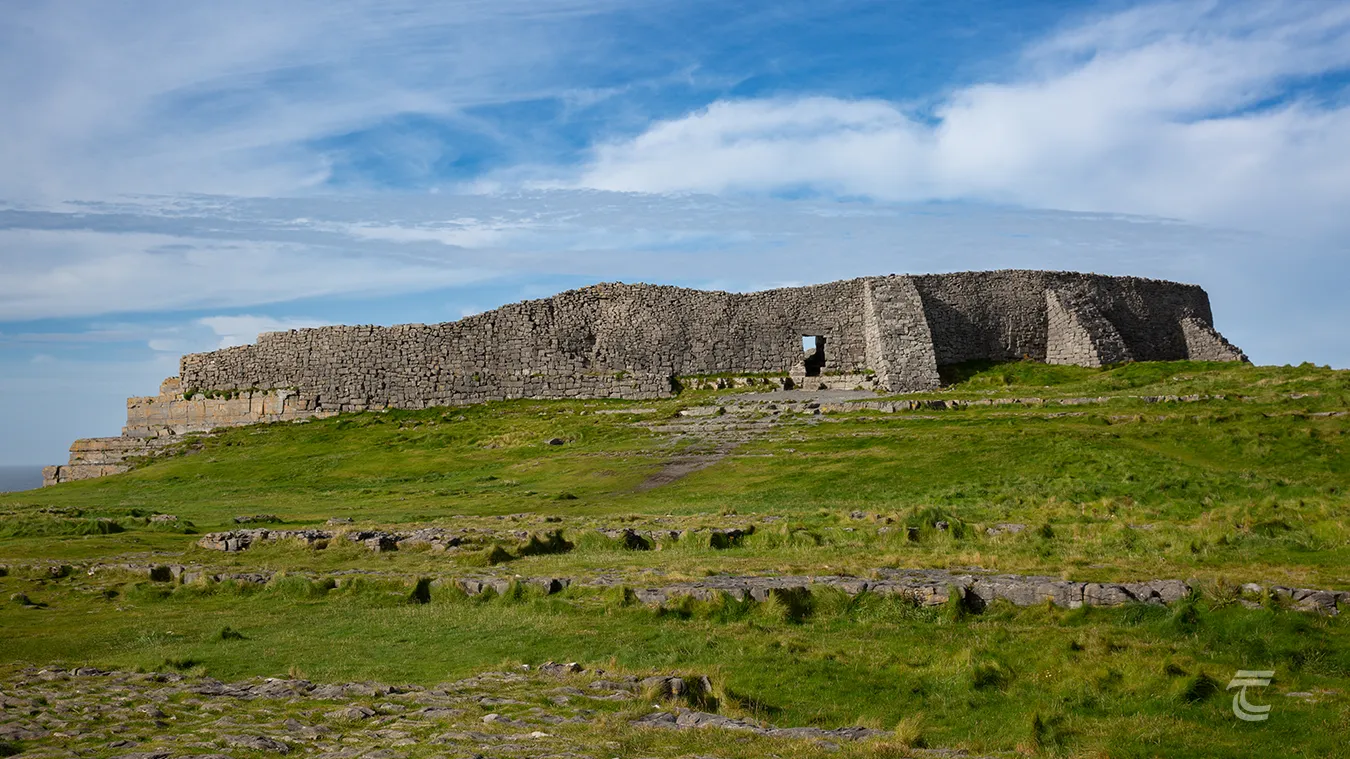
The mighty stone walls of the inner enclosure of Dún Aonghasa • Inis Mór
The History of Dún Aonghasa | Dun Aengus
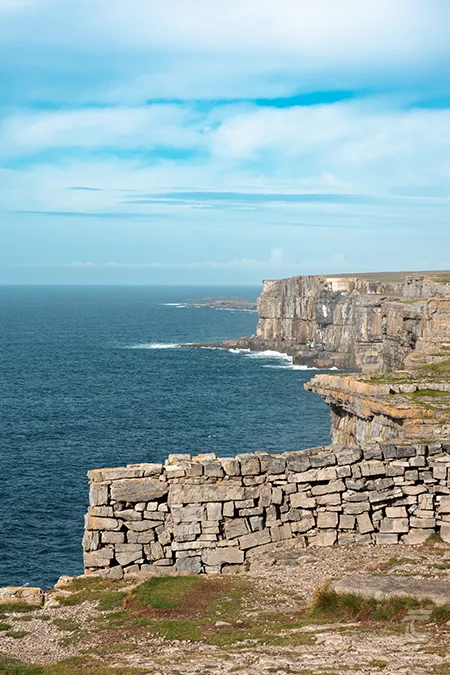
The limestone cliffs at Dún Aonghasa • Inis Mór
From its early beginnings, Dún Aonghasa would have been comparable to some of the high status hillforts on the mainland. These were important places in society, where communal activities would take place like inaugurations or religious ceremonies, and a place where agreements could be made or disputes ruled upon and justice dispensed. Certainly, the establishment of a large fort here would have taken the cooperation and labour of a large number of people, and this hints at a strong social cohesion during the Bronze Age. Interestingly, a considerable amount of evidence for Bronze Age metalworking was discovered on the site during excavations carried out by Claire Cotter and the Discovery Programme. Perhaps at this early period the manufacture of metal tools was akin to sorcery, a secret skill and knowledge reserved only for the select few, to be practised only within certain important, and perhaps sacred, places. Similar evidence was also found at the broadly contemporary Rathgall Hillfort in County Wicklow.
As well as its formidable boundary walls, Dún Aonghasa possessed a further layer of defence – a chevaux de frise that surrounded the middle enclosure of the fort. This chevaux de frise was a band of large stones, some up to 2m (6.5 feet) tall, that were stood upright by being wedged and propped up with other large stones. The tightly packed pillars would have made it difficult for enemy forces to advance in a group or to form a shieldwall on their approach. As the bedrock of the land makes it difficult to dig, this was a very practical and effective alternative to a deep ditch.
During the early medieval period, Dún Aonghasa was transformed with an enormous amount of construction that incorporated the Bronze Age enclosures within massive new drystone walls. These were much higher and broader than the originals, and almost swallowed the older walls within the new fabric. This is clearly seen with the middle enclosure, where the original Bronze Age wall was almost doubled in both width and height. The inner enclosure was also refortified during the early medieval period. At this time, the Aran Islands were a disputed territory, as a frontier point between Connacht and Munster. The redevelopment of the ancient fort was a powerful statement of the dominance and power of the ruling family. Archaeologists also found evidence of early medieval houses within the inner enclosure, along with a brooch-pin, a comb and burials, including the remains of two young men dated to between AD 680–950.

The limestone cliffs at Dún Aonghasa • Inis Mór
Dún Aonghasa was declared a National Monument in 1880, and extensive works were carried out to restore and repair the site. The appearance of the site today is largely a result of those restorations. Dún Aonghasa is under the auspices of the Office of Public Works, and it is one of the most popular visitor attractions in Ireland. It is a truly affecting experience, to stand at the very edge of Europe and look out past the dizzying cliffs to the Atlantic below, knowing that Newfoundland, over 3,000km (approximately 1,900 miles) away, is the next shore. You can discover an introduction to the story of Dún Aonghasa at the visitor centre, and guided tours of the site are available. You can also hear the story of Dún Aoghasa in the free audio guide that we produced on behalf of Aran Island Ferries. You’ll find the Aran Islands Audio Guide on your favourite podcast platform, or on the Abarta Heritage Website. Dún Aonghasa is one of the highlights of our Inis Mór (Inishmore) Itinerary, available for members of Tuatha here.
Upper left: the path to Dún Aonghasa • Lower left: a view of the inner enclosure • Right: the walls of the inner enclosure
Top: the path to Dún Aonghasa • Middle: the walls of the inner enclosure • Bottom: a view of the inner enclosure
